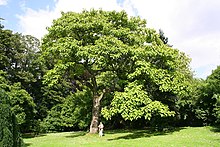Paulownia tomentosa
| Empress tree | |
|---|---|
 |
|
| Paulownia tomentosa | |
| Scientific classification | |
| Kingdom: | Plantae |
| (unranked): | Angiosperms |
| (unranked): | Eudicots |
| (unranked): | Asterids |
| Order: | Lamiales |
| Family: | Paulowniaceae |
| Genus: | Paulownia |
| Species: | P. tomentosa |
| Binomial name | |
|
Paulownia tomentosa (Thunb.) Steud. |
|
Paulownia tomentosa (common names princesstree,foxglove-tree,empress tree or kiri) is a deciduous tree in the family Paulowniaceae, native to central and western China. Paulownia tomentosa is an extremely fast-growing tree, and is a persistent exotic invasive in North America.
The generic name Paulownia honors Anna Pavlovna of Russia. The specific epithet tomentosa is a Latin word meaning ‘covered in hairs’.
This tree grows 10–25 m (33–82 ft) tall, with large heart-shaped to five-lobed leaves 15–40 cm (6–16 in) across, arranged in opposite pairs on the stem. On young growth, the leaves may be in whorls of three and be much bigger than the leaves on more mature growth. The leaves can be mistaken for those of the catalpa.
The very fragrant flowers are produced before the leaves in early spring, on panicles 10–30 cm long, with a tubular purple corolla 4–6 cm long resembling a foxglove flower. The fruit is a dry egg-shaped capsule 3–4 cm long, containing numerous tiny seeds. The seeds are winged and disperse by wind and water. Pollarded trees do not produce flowers, as these only form on mature wood.
Paulownia tomentosa can survive wildfire because the roots can regenerate new, very fast-growing stems. It is tolerant of pollution and it is not fussy about soil type. For this reason it functions ecologically as a pioneer plant. Its nitrogen-rich leaves provide good fodder and its roots prevent soil erosion. Eventually, Paulownia is succeeded by taller trees that shade it. It cannot thrive in the shade of other trees.
Paulownia tomentosa is cultivated as an ornamental tree in parks and gardens. It has gained the Royal Horticultural Society's Award of Garden Merit.
...
Wikipedia
